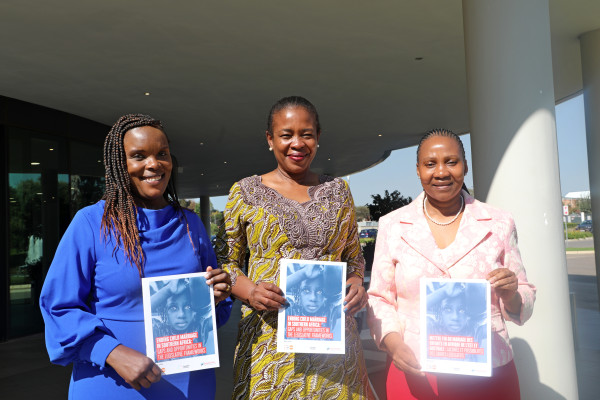

Southern Africa Development Community (SADC) countries have taken commendable action to strengthen legal protections; however, there has been little or no progress by other Member States, and greater efforts are needed across the board to end child marriage.
Child marriage remains a widespread and persistent problem across Southern Africa. Two policy briefs on ending child marriage, highlighting the Gaps and Opportunities in Legislative Frameworks (https://apo-opa.info/41qHdka) and Domesticating the SADC Model Law in Child Marriage (https://apo-opa.info/3O17ORN) by the United Nations Population Fund (UNFPA) and Equality Now were presented to the Standing Committees of the Southern African Development Community (SADC) Parliamentary Forum.
The policy briefs focus on the progress of domesticating the SADC Model Law on Eradicating Child Marriage and Protecting Children Already in Marriage (Model Law) (https://apo-opa.info/41tqXiv) amongst SADC member countries, and focus on the gaps and opportunities in the laws that SADC countries have in place.
They identify obstacles impeding progress, including inconsistencies in national laws and a general lack of effective implementation of these laws, leading to low prioritization that impacts decisions to address child marriage. It also highlights positive legal advances, and makes recommendations to governments for strengthening eradication efforts.
SADC Model Law on child marriage
Child marriage is a formal or informal union where one or both parties are under 18 years old. Poverty, gender inequality, and cultural or religious beliefs affect girls. Child marriage places girls at increased risk of physical, sexual, and emotional abuse, and it keeps many trapped in a cycle of poverty. There is also a close correlation between early pregnancy and child marriage, which can be dangerous for the young mother and the baby.
The Model Law recognizes child marriage as a violation of children’s rights, including the right to health, education, and protection from harm. It sets the minimum age of marriage as 18 for both boys and girls without exceptions and promotes a comprehensive, multi-sectoral approach to ending child marriage.
The Model Law calls for a range of actions, including the unequivocal prohibition of marriage of children, the elimination of all legal and customary laws that permit it, and legal penalties for violations. It promotes the registration of births and marriages and requires that any marriage involving a child be declared null and void.
Gaps in protection
Despite commendable efforts by some governments, UNFPA and Equality Now identified various gaps in applying the Model Law. Deeply entrenched cultural practices, poverty, and limited access to education and sexual and reproductive healthcare are slowing progress and hindering efforts to reform marriage and family laws.
While legal reform remains a key strategy in addressing child marriage, the report recommends that governments close the divide between legal approaches and approaches aimed at influencing social and community norms. This requires balancing community awareness-raising with the prosecution and punishment of perpetrators.
“We call upon SADC Member States to prioritize legal reform to comply with international and regional human rights obligations and ensure that the minimum age of marriage is set at 18 across the board, without any exceptions. These laws also need to be effectively implemented using a multi-sectoral approach with adequate budgetary allocation,” summarises Divya Srinivasan, a human rights lawyer at Equality Now.
UNFPA East and Southern Regional Office Deputy Regional Director, Justine Coulson concludes, “Legal approaches need to be better embedded in the overall approach to ending child marriage. The Model Law is not just a proposed minimum standard indicating a need for compliance. It is an expression of social values and zero tolerance for child marriage, GBV and contributing to the improvement of SRHR such as reduction of teenage pregnancy.”
Distributed by APO Group on behalf of Equality Now.
For media inquiries, please contact:
Daisy Diamante Leoncio,
UNFPA East and Southern Africa Regional Communications Adviser
E-mail leoncio@unfpa.org
Tara Carey,
Global Head of Media,
Equality Now,
E-mail: tcarey@equalitynow.org, M: +447971556340
Sylvia Obaga,
Regional Communications Manager- Africa,
Equality Now,
E-mail: sobaga@equalitynow.org,
M: +254706142804
About the SADC Model Law:
The SADC Model Law on Eradicating Child Marriage and Protecting Children Already in Marriage (‘Model Law’ or ‘SADC Model Law’) was adopted on June 3rd 2016 by the 39th Plenary Assembly of the SADC Parliamentary Forum, which met in the Kingdom of Eswatini.
About Equality Now:
Equality Now (https://www.EqualityNow.org/) is an international non-governmental human rights organization that works to protect and promote the rights of women and girls around the world by combining grassroots activism with international, regional, and national legal advocacy. Our international network of lawyers, activists and supporters achieve legal and systemic change by holding governments responsible for enacting and enforcing laws and policies that end legal inequality, sex trafficking, online sexual exploitation, sexual violence, and harmful practices such as female genital mutilation and child marriage.
About UNFPA:
UNFPA (https://www.UNFPA.org/) is the United Nations sexual and reproductive health agency. Our mission is to deliver a world where every pregnancy is wanted, every childbirth is safe and every young person’s potential is fulfilled.






